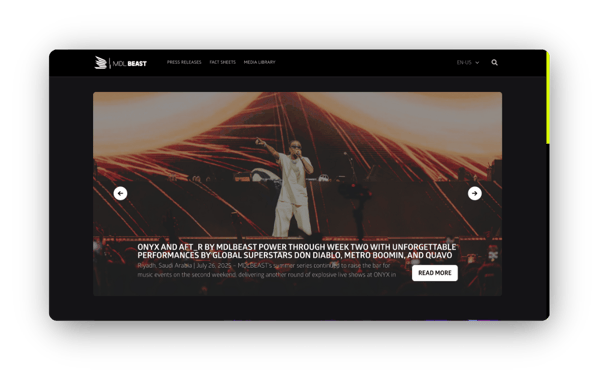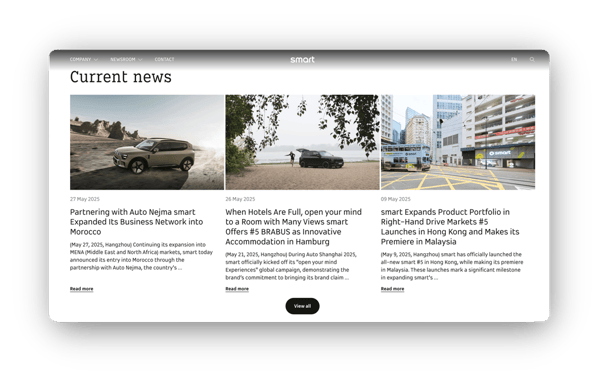|
A real newsroom is built for media. It’s where stories thrive, where journalists find what they need, and where your brand controls its narrative without fighting through bottlenecks. If your in-house comms team wants to publish fast, be credible, and stay visible amid the chaos of AI-generated content and misinformation, it starts with one thing: your newsroom. |
What is an online newsroom?
An online newsroom (also called a digital newsroom, brand newsroom, or corporate newsroom) is your brand’s central, always-on hub for news.
It’s where press releases, brand assets, and media kits sit together with contact details, quotes, multimedia, and distribution tools - all built for journalists, stakeholders, search engines, and more recently, AI generative search.
How it differs from a blog or press/media page:
|
Platform |
Primary audience |
Purpose |
Publishing style |
Standard features |
|
Blog |
Customers & fans |
Storytelling, education, and marketing content |
Evergreen |
Articles, brand updates, thought pieces |
|
Press/Media page |
Journalists (sort of) |
Basic press release storage and static company updates |
Static |
Static list of releases, maybe contact email |
|
Online newsroom |
Journalists & media teams |
Dynamic publishing hub for verified news and brand storytelling |
Live/Ongoing |
Searchable press releases, media kits, assets, analytics, global publishing |
Most brands think they have a newsroom when, in reality, they have an archive. A newsroom lives and breathes, updating as fast as your story does.
So, in short:
- A blog tells your brand story.
- A press/media page stores old releases.
- A newsroom manages your narrative in real time.
"We were used to having to do a lot of things manually. Right now, we can easily create a release [in Presspage] and publish it directly on our website."
Jarosław R. Morawski, e-commerce & CRM, Mercedes-Benz Poland
Read the case study >>>
The kind of efficiency Jarosław is talking about is no longer a luxury. According to PRLab’s 2025 Public Relations Statistics Report, 25% of brands publish more than ten press releases a year, roughly one per month. Your newsroom needs to be able to keep up; otherwise, you’ll be left in the dust.
|
RESOURCE ALERT Want to learn how to write the PERFECT press release? We’ve got you covered with this helpful guide, including best practices and example templates. |
Key Features of a Digital Newsroom
Every modern newsroom shares a common thread: they’re built for speed, clarity, and discoverability. Here’s just some of the key features that deliver on that:
1. Press releases and announcements
The core of any newsroom. Timely, properly tagged, fully branded. Press releases are still the most trusted format for journalists, with 72% of journalists saying they prefer press releases from PR professionals.
2. Press kit and brand assets
Journalists shouldn’t have to email you for logos or images. A good newsroom hosts everything from logos and brand elements to executive headshots, product shots, videos, infographics and more, all downloadable in one click.
|
RESOURCE ALERT |
3. Contact details that actually work
It sounds basic, but most corporate sites still bury media contact info. A newsroom keeps these front and centre, ideally segmented by region or topic.
4. Multimedia integration
Visual content isn’t optional anymore. 63% of companies now include multimedia assets like images and infographics to improve engagement. Video press releases, image galleries, audio quotes - they all impact pickup.
5. Search and filter functionality
If journalists can’t find your news, they’ll find someone else’s. Tag content by category, topic, product, or geography. Make navigation effortless.
6. Distribution and scheduling
One button to publish across multiple regions, languages, and contact lists. No more midnight calls to agencies or assistants!
7. Analytics and reporting
Modern newsrooms come with dashboards that show traffic, engagement, and asset downloads. Knowing what performs means you can adapt, pitch smarter, and prove ROI to leadership.
When you stack these features together, your newsroom becomes more than a repository. It becomes your single source of truth and the control room for your brand’s reputation.
Why an Online Newsroom Matters
You likely already have the stories. What you probably don’t have is the structure to get them out quickly, clearly, and in the right format for journalists. That’s where a modern digital newsroom proves its worth.
Easier access for journalists
Journalists are busier (and more sceptical) than ever.
More than half receive around a hundred pitches a week, sometimes more, and most of them miss the mark. They don’t want emails that say “Let me know if you’d like images.” They want everything, right there, when they click. A newsroom does that. It keeps every asset, quote, and detail accessible 24/7 - no chasing, no attachments, no barriers.
When media can find what they need, coverage increases. According to eReleases, 68% of brands that publish regular press releases benefit from improved visibility.
Take Lufthansa Group. Before adopting Presspage, each release required multiple approvals and manual sends. Now, one person can publish a fully formatted, analytics-enabled story in under ten minutes. That’s how modern PR moves.
More control over your brand story
Social platforms shift algorithms. Search engines rewrite rules. But your newsroom? That’s yours. Your brand’s verified, centralised source of truth. Today, that matters more than ever.
In 2025, the World Economic Forum listed misinformation and disinformation as “pressing risks”, highlighting declining trust in institutions as a major concern.
Your own digital newsroom gives you a way to fight back; one canonical version of every story, quote, and image - ready for media, discoverable by search, and trusted by readers.
Better SEO and visibility
Think of your newsroom as a mini-publication. Each release, asset, and update can rank in search, build authority, and feed journalists accurate information.
According to PRLab, 95% of PR teams now use newsroom software that integrates SEO tools, because more and more, visibility is structure over luck.
Optimising meta titles, linking to previous releases, and hosting media assets under one domain all add up. When journalists Google your brand name + topic, your newsroom should appear first (not a third-party article quoting you incorrectly).
The kick-back? Each newsroom post can earn backlinks, which fuel organic visibility for the rest of your site. In short: you’re publishing news AND you’re strengthening your brand’s search presence, in one fell swoop.
Staying visible in an AI-assisted media landscape
AI writing and aggregation tools now crawl news sites by default. If your newsroom isn’t optimised, your content may appear stripped of context elsewhere.
By structuring your releases properly (metadata, bylines, date stamps, canonical links), your newsroom acts as a verified signal source for AI search engines.
As Presspage CEO Jan-Willem Schalkwijk noted in a recent post;
“When it comes to AI, trust and authority beat backlinks every time.”
Your newsroom is how you build both.
|
HOW PRESSPAGE DOES IT Modules in Presspage are built to make your newsroom easy for humans AND AI to read. Because your newsroom lives directly on your domain and not an external subsite, it carries your full domain authority. That means when AI tools or search crawlers look for verified sources, your newsroom stands a better chance of being picked up. |
Faster publishing and fewer bottlenecks
Traditional PR processes often look like this:
Write → Approve → Format → Email → Upload → Wait.
By the time it’s live, the story’s already old. Automation changes that.
Studies show that automation in newsroom software saves PR teams an average of 6.2 hours per week on repetitive tasks like reporting and media monitoring. That’s nearly a full workday, every week, freed up for storytelling instead of admin. Global comms teams running multi-lingual campaigns feel this most. A multi-region newsroom setup lets each local team adapt content without breaking design or workflow.
"As creating more local news is encouraged within the company, we can easily access local items to align with the global communication strategy."
Gunjan Khandelwal, Specialist PR and Communications, smart Automobile
Read the case study >>>
Online Newsroom Examples
Seeing it in practice makes it real. Here’s how a few organisations use online newsrooms to keep control and move faster:
Lufthansa Group
Full PR control, no turbulence
Before:- Approvals bounced from person to person
- Evening releases meant delays, overtime, and extra coordination
- Even small changes required partner buy-in
After: One person handles the entire release, start to finish, in under 10 minutes. Editing happens live in the newsroom, minimising delays, and campaigns and updates are managed from one central hub.
MBLBeast
Bringing clarity to music PR
Before:
- Press releases sent manually, one by one
- No single source of information for journalists
- Press kits had to be built from scratch for every request
After: One platform, fully in sync. MDLBeast now has a centralised hub for all its press materials, faster distribution through organised mailing lists, and easy self-service access for the media.
smart Automobile
International expansion at scale
Before:
- Disjointed, inefficient comms strategy
- Limited regional engagement
- Messy tooling & siloed teams made media relations challenging
After: smart Automobile now oversees a unified, scalable global comms solution, streamlining global and local communications. They have seen a 450% increase in newsroom traffic across their 13 local newsrooms and are primed for continued growth.
What do all three have in common? Their newsrooms work as infrastructure, letting comms teams act fast without depending on IT, agencies, or endless email chains.
The Takeaway
If you’ve made it this far, you already know the answer to “What is an online newsroom?” It’s the home of your brand’s story; the bridge between your internal comms team and the outside world.
A good newsroom does three things brilliantly:
- Keeps journalists and stakeholders informed
- Gives your team control and flexibility
- Protects your brand narrative against misinformation and outdated workflows
It’s about being found, trusted, and ready when your next story hits.
Ready to build yours?
Download the Ultimate Guide to Brand Newsrooms and see how Presspage newsroom software helps comms teams publish faster, work smarter, and take full control of their story.







